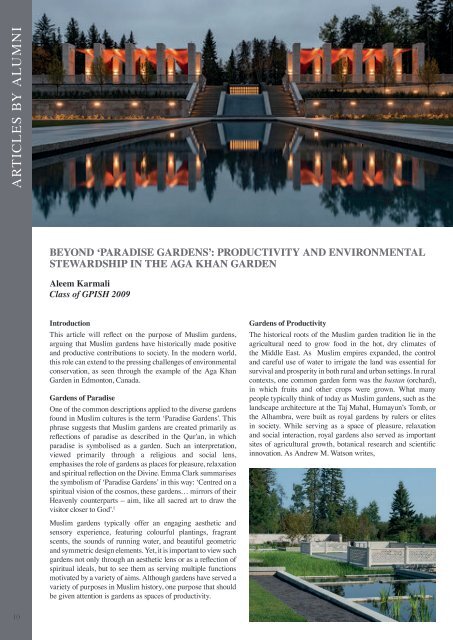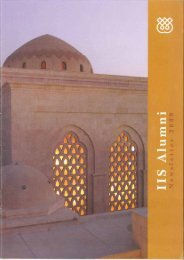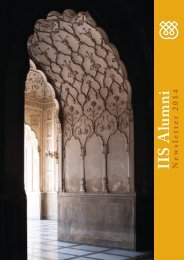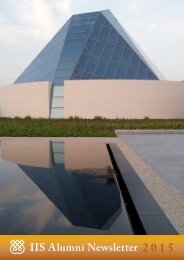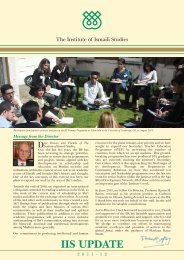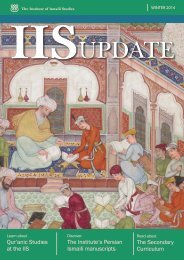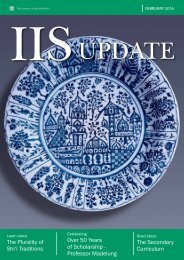IIS Alumni Newsletter 2018
Create successful ePaper yourself
Turn your PDF publications into a flip-book with our unique Google optimized e-Paper software.
ARTICLES BY ALUMNI<br />
BEYOND ‘PARADISE GARDENS’: PRODUCTIVITY AND ENVIRONMENTAL<br />
STEWARDSHIP IN THE AGA KHAN GARDEN<br />
Aleem Karmali<br />
Class of GPISH 2009<br />
Introduction<br />
This article will reflect on the purpose of Muslim gardens,<br />
arguing that Muslim gardens have historically made positive<br />
and productive contributions to society. In the modern world,<br />
this role can extend to the pressing challenges of environmental<br />
conservation, as seen through the example of the Aga Khan<br />
Garden in Edmonton, Canada.<br />
Gardens of Paradise<br />
One of the common descriptions applied to the diverse gardens<br />
found in Muslim cultures is the term ‘Paradise Gardens’. This<br />
phrase suggests that Muslim gardens are created primarily as<br />
reflections of paradise as described in the Qur’an, in which<br />
paradise is symbolised as a garden. Such an interpretation,<br />
viewed primarily through a religious and social lens,<br />
emphasises the role of gardens as places for pleasure, relaxation<br />
and spiritual reflection on the Divine. Emma Clark summarises<br />
the symbolism of ‘Paradise Gardens’ in this way: ‘Centred on a<br />
spiritual vision of the cosmos, these gardens… mirrors of their<br />
Heavenly counterparts – aim, like all sacred art to draw the<br />
visitor closer to God’. 1<br />
Gardens of Productivity<br />
The historical roots of the Muslim garden tradition lie in the<br />
agricultural need to grow food in the hot, dry climates of<br />
the Middle East. As Muslim empires expanded, the control<br />
and careful use of water to irrigate the land was essential for<br />
survival and prosperity in both rural and urban settings. In rural<br />
contexts, one common garden form was the bustan (orchard),<br />
in which fruits and other crops were grown. What many<br />
people typically think of today as Muslim gardens, such as the<br />
landscape architecture at the Taj Mahal, Humayun’s Tomb, or<br />
the Alhambra, were built as royal gardens by rulers or elites<br />
in society. While serving as a space of pleasure, relaxation<br />
and social interaction, royal gardens also served as important<br />
sites of agricultural growth, botanical research and scientific<br />
innovation. As Andrew M. Watson writes,<br />
Muslim gardens typically offer an engaging aesthetic and<br />
sensory experience, featuring colourful plantings, fragrant<br />
scents, the sounds of running water, and beautiful geometric<br />
and symmetric design elements. Yet, it is important to view such<br />
gardens not only through an aesthetic lens or as a reflection of<br />
spiritual ideals, but to see them as serving multiple functions<br />
motivated by a variety of aims. Although gardens have served a<br />
variety of purposes in Muslim history, one purpose that should<br />
be given attention is gardens as spaces of productivity.<br />
10


